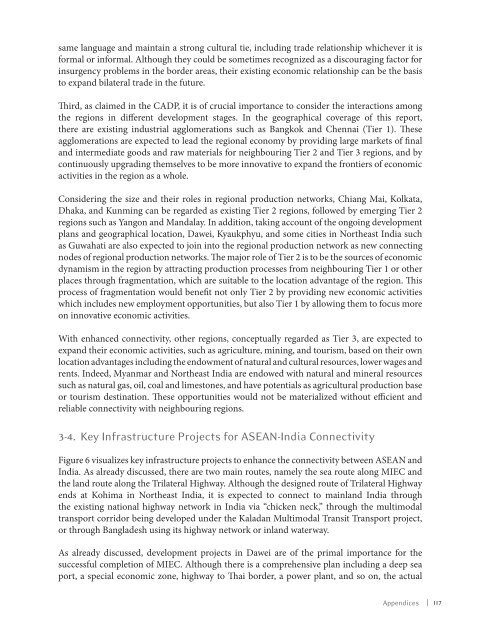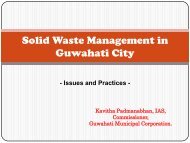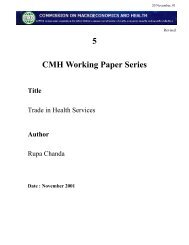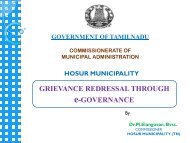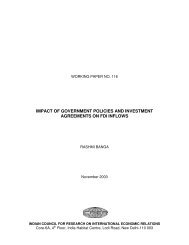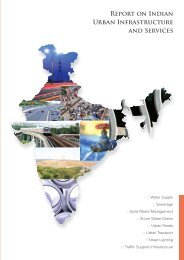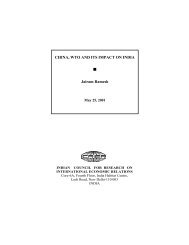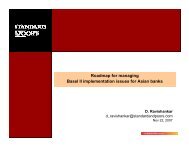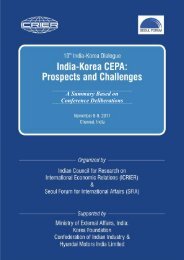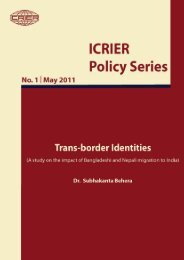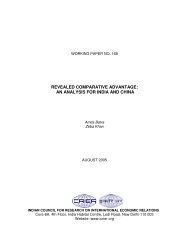Asia's Arc of Advantage - icrier
Asia's Arc of Advantage - icrier
Asia's Arc of Advantage - icrier
You also want an ePaper? Increase the reach of your titles
YUMPU automatically turns print PDFs into web optimized ePapers that Google loves.
same language and maintain a strong cultural tie, including trade relationship whichever it is<br />
formal or informal. Although they could be sometimes recognized as a discouraging factor for<br />
insurgency problems in the border areas, their existing economic relationship can be the basis<br />
to expand bilateral trade in the future.<br />
Third, as claimed in the CADP, it is <strong>of</strong> crucial importance to consider the interactions among<br />
the regions in different development stages. In the geographical coverage <strong>of</strong> this report,<br />
there are existing industrial agglomerations such as Bangkok and Chennai (Tier 1). These<br />
agglomerations are expected to lead the regional economy by providing large markets <strong>of</strong> final<br />
and intermediate goods and raw materials for neighbouring Tier 2 and Tier 3 regions, and by<br />
continuously upgrading themselves to be more innovative to expand the frontiers <strong>of</strong> economic<br />
activities in the region as a whole.<br />
Considering the size and their roles in regional production networks, Chiang Mai, Kolkata,<br />
Dhaka, and Kunming can be regarded as existing Tier 2 regions, followed by emerging Tier 2<br />
regions such as Yangon and Mandalay. In addition, taking account <strong>of</strong> the ongoing development<br />
plans and geographical location, Dawei, Kyaukphyu, and some cities in Northeast India such<br />
as Guwahati are also expected to join into the regional production network as new connecting<br />
nodes <strong>of</strong> regional production networks. The major role <strong>of</strong> Tier 2 is to be the sources <strong>of</strong> economic<br />
dynamism in the region by attracting production processes from neighbouring Tier 1 or other<br />
places through fragmentation, which are suitable to the location advantage <strong>of</strong> the region. This<br />
process <strong>of</strong> fragmentation would benefit not only Tier 2 by providing new economic activities<br />
which includes new employment opportunities, but also Tier 1 by allowing them to focus more<br />
on innovative economic activities.<br />
With enhanced connectivity, other regions, conceptually regarded as Tier 3, are expected to<br />
expand their economic activities, such as agriculture, mining, and tourism, based on their own<br />
location advantages including the endowment <strong>of</strong> natural and cultural resources, lower wages and<br />
rents. Indeed, Myanmar and Northeast India are endowed with natural and mineral resources<br />
such as natural gas, oil, coal and limestones, and have potentials as agricultural production base<br />
or tourism destination. These opportunities would not be materialized without efficient and<br />
reliable connectivity with neighbouring regions.<br />
3-4. Key Infrastructure Projects for ASEAN-India Connectivity<br />
Figure 6 visualizes key infrastructure projects to enhance the connectivity between ASEAN and<br />
India. As already discussed, there are two main routes, namely the sea route along MIEC and<br />
the land route along the Trilateral Highway. Although the designed route <strong>of</strong> Trilateral Highway<br />
ends at Kohima in Northeast India, it is expected to connect to mainland India through<br />
the existing national highway network in India via “chicken neck,” through the multimodal<br />
transport corridor being developed under the Kaladan Multimodal Transit Transport project,<br />
or through Bangladesh using its highway network or inland waterway.<br />
As already discussed, development projects in Dawei are <strong>of</strong> the primal importance for the<br />
successful completion <strong>of</strong> MIEC. Although there is a comprehensive plan including a deep sea<br />
port, a special economic zone, highway to Thai border, a power plant, and so on, the actual<br />
Appendices<br />
| 117


